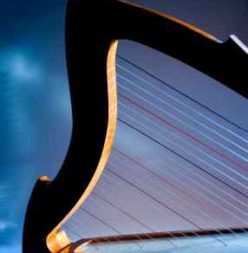Q: When I started piano, my teacher would cover my hands with paper so I couldn’t watch them. She said watching my hands would make me slower. When I see harpists perform, they almost always have their music memorized and watch their hands when they play. Is this how you are supposed to play, or can a harpist learn to play by touch? I’m just wondering how anyone can memorize hundreds of pieces for performing. –Helen, in South Carolina
There are several reasons why harpists watch their hands. We all learn differently, but for many of us, going back and forth from the music to our hands gives us tennis neck. Memorizing means we play better and get less lost. Harp strings are harder to see and find than piano keys, and watching the patterns on the strings actually teaches us the music.
There is no one right way to play the harp. It is of course possible to play without looking at your hands, but harder than it is on the piano (and gravity is not on our side). Many of us use music at least part of the time, especially for longer gigs. Knowing your chords so you can play without reading every note is a huge help, not just to playing from music without having to study every note, but to learning to play without it (and to memorize, as well).
If you learn to improvise and “make things up”, and you can pick out melodies here and there, you can play for a long time without anyone else’s music (in sight or memorized). There are many ways to gain fluency; you just need to find what works best for you.
This post is adapted from material that I originally published in the ezine, Notes from the Harp.
